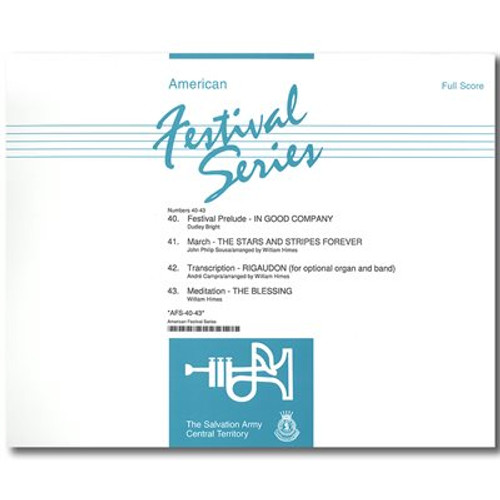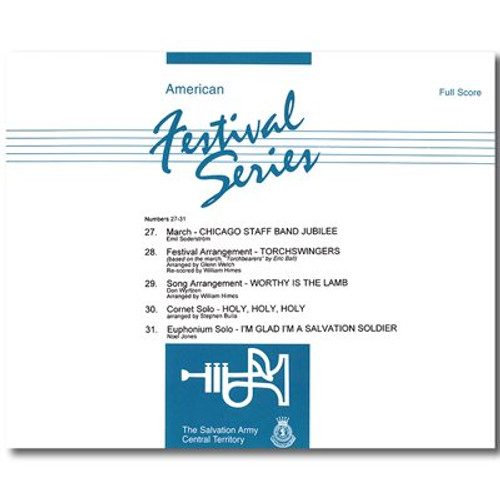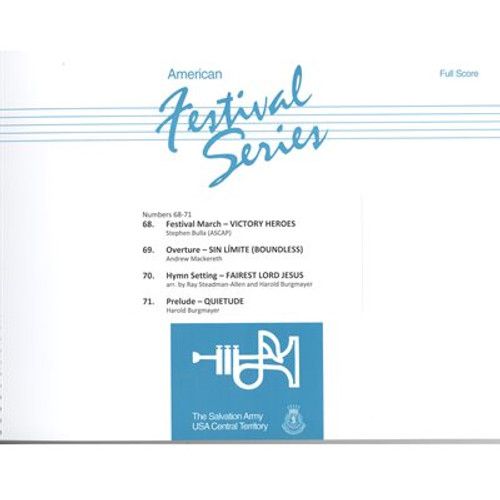Product Description
September 2013 Nos. 47-50
Brian Bowen, Editor
Comments by
Staff Bandmaster William Himes
Music & Gospel Arts Secretary, USA Central Territory
Score Sample(view series guide)
47. Transcription - Marche Triomphale Sigfrid Karg-Elert, arr. William Himes Notes 48. Rhapsody - To Worlds Unknown Stephen Bulla Notes 49. Cornet Solo - Garments of Peace Robert Redhead Notes 50. Song Arrangement - Glorify Thy Name Gerry Shoults Notes
Produced by The Salvation Army - Central Territory47. Transcription - Marche Triomphale
Program Note:
The music of Sigfrid Karg-Elert (1877-1933) represents a peak of late Romantic music in its emotional intensity, variety of styles and imaginative use of resources. A virtuoso organist, this work is among the composer's best-known and most lasting works.Note to the Conductor:
This transcription is well suited to the majestic sonorities of the brass band. While the music is convincing and complete with band alone, when the opportunity presents itself to include pipe organ, the result can be spectacular.
The conductor is encouraged to observe the unhurried, stately tempo and encourage players to emulate the full-rounded sonorities of the instrument for which the music was originally written. Make clear distinctions between all grades of dynamics, especially f and ff. Likewise, take full advantage of the quiet contrast at bars 33-46.
The pace should be steady throughout, allowing for a majestic and sonorous ritardando in the closing bars.48. Rhapsody - To Worlds Unknown
Program Note:
This exciting music is based primarily on melodic fragments from the song "Will your anchor hold?," depicting the "storms of life" and the persistent question of drifting or standing firm. A reflective setting which follows features "Rock of Ages" (solo flugel) and portrays the eternal reward of the faithful: "..When I soar to worlds unknown, see thee on thy judgement throne, Rock of ages, cleft for me, let me hide myself in thee." (Augustus Toplady) This challenging work concludes with a triumphant return to the opening chorus: "We have an anchor that keeps the soul steadfast and sure while the billows roll."Note to the Conductor:
Stephen Bulla has created a rhapsody of considerable craft, color and technical challenge. Written for the Chicago Staff Band's centennial (1907-2007), this work is a celebration of music ministry for brass and percussion.
Introduction - bar 31: Opening with a flourish of counterpoint, it is essential for each section enter confidently and with rhythmic precision. Bars 12-17 employ cluster chords that will require careful balance. (Pay particular attention to the chord intonation at bars 30-31, especially the half-step between 2nd cornet and 1st horn.)
Bars 32-57: The first presentation of the main theme, "Will your anchor hold?" is light, syncopated and straightforward, with playful interjections from euphonium, flugel and tubas, respectively.
Bars 58-91: This section will present some of the most technically challenging music for almost every instrument group. Players should strive to observe the given dynamics (mf-f) and avoid heavy articulations. (Lighter is better.)
Bars 91-96: Although the trombone section is the only accompaniment to the Bb bass solo, care must be taken avoid obscuring this rare orchestration, given the low register and quiet dynamic (mp).
Bars 97-138: There is no question that the cornet duet and horn solo in bars 97-100 are down-right tricky! But the key to the feel of these few bars will be the gentle 9/8 sway provided by euphonium and Eb bass. The composer skillfully exploits the duple characters of the melody (cornets) and countermelody (horns) against the compound meter in the accompaniment (trombones, basses). This will require ensemble and metrical independence from each group.
Bars 139-152: This intense and plaintive section at bars 126-133 soon fades into a tranquil, transparent rendering of Augustus Toplady's hymn tune, "Rock of ages," tenderly scored for solo flugel.
Bars 153-160: In just two bars (151-152) the mood and tempo increase slightly as the music reaches a brief moment of intensity (bars 153-156), quickly subsiding to feature another rare soloist, the bass trombone. Therefore the lead-in decrescendo must be quick and steep in order for the soloist to be heard from the outset.
Conductors will want to take full advantage of the fermata at bar 160 in order to set for the new tempo (and sudden allegro) in the next section.
Bars 161-211: Carefully gauge the speed (126) of this joyful episode to assure clarity through the technical passages as they come and go (i.e., bars 183-185, 200-202.)
Bars 212-end: The percussion section's crescendo into bar 213 is essential to the climactic final chorus of "We have an anchor." A scintillating coda from bar 220 to the end calls for the brightest tempo (138) while holding in reserve the biggest sounds for the final two bars. Again, percussion - especially timpani - are key to this triumphant conclusion.49. Cornet Solo - Garments of Peace
Program Note:
An expressive devotional solo featuring "The Prayer of St. Francis" by Sebastian Temple interwoven with the composer's original chorus, "Please clothe me, Lord."Note to the Conductor:
This transparent score presents few technical challenges yet it requires the utmost sensitivity and musicianship to make these lyrical themes 'sing.' Other than the tutti section leading to the climactic peak at bars 50-56, the overall mood is that of quiet contemplation. Score notations provide the soloist with several performance options (flugel, cornet, trumpet.) However, this work is also effective using cornet throughout.50. Song Arrangement - Glorify Thy Name
Program Note:
A sensitive setting of Donna Adkins' well-loved hymn of adoration and worship.Note to the Conductor:
Warm harmonies and gentle orchestration aptly frame the setting of this simple yet meaningful song. This accessible setting is especially effective in worship services and other devotional settings.







